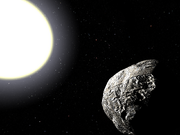You can help improve this page by clicking this.

An image of the four terrestrial planets, Mercury, Venus, Earth, and Mars.
The Inner Solar System is the closest region of the solar system to the Sun, and consists of four planets: Mercury, Venus, Earth and Mars, and every asteroid inside the orbit of Jupiter, except asteroids in resonance with Jupiter's L4,5,3
The Sun[]
The Sun is a large ball of gas on the middle of our solar system that keeps it all together. It is mostly made of Hydrogen and Helium, and is white in color. It has solar flares and sunspots. Earth is located 150 million kilometers from it, and it is 1.39 million kilometers in diameter, as well as being 333,000 times more massive then our Earth.

Artist’s impression of a Vulcanoid, being close to the sun, and asteroid-like.
Vulcanoids[]
Vulcanoids are a hypothetical type of asteroids that orbit the sun closer than Mercury does. The name comes from Vulcan, a hypothetical planet that was thought to orbit the sun inside of Mercury’s orbit in the 1800s, but was disproven.
Planets[]
There are 4 planets in the inner solar system, being Mercury, Venus, Earth, and Mars.
Mercury[]
Mercury is the closest planet to the sun. It is by far the 3rd least explored planet in the solar system, with only 3 missions having arrived at it so far. It is grey in color, and is the smallest planet. It is covered in craters, like the moon of Jupiter, Callisto.
Venus[]
Venus is the second planet from the sun. It has a large atmosphere and is the brightest planet in the night sky on average. It has many mountains, and is the hottest planet in the solar system.

Texture of the Atmosphere of Venus, taken from Spacepedia.
Atmosphere of Venus[]
Venus has the thickest and largest atmosphere of any terrestrial planet. It has a greenhouse effect that makes Venus the hottest planet, and is white in color.
